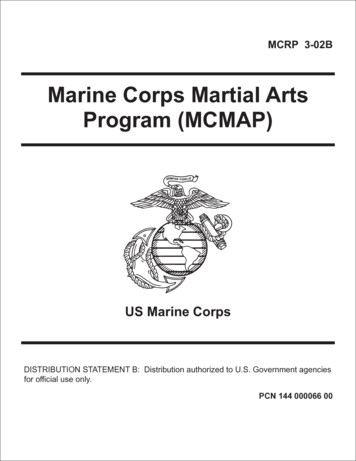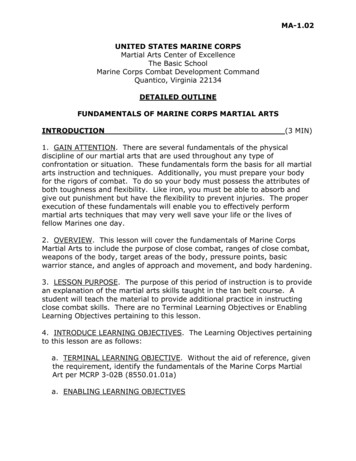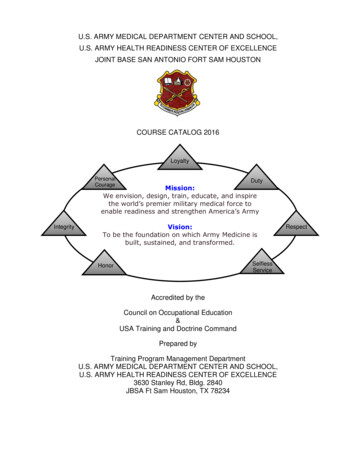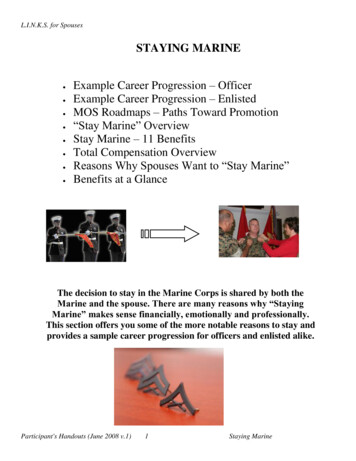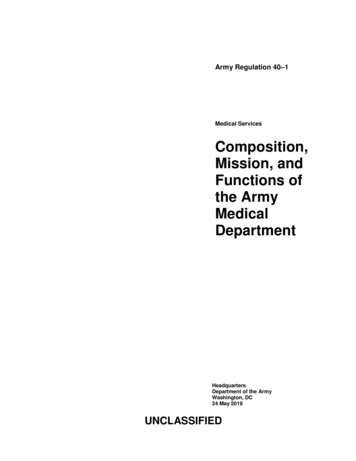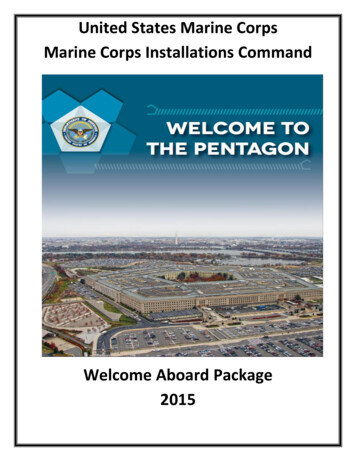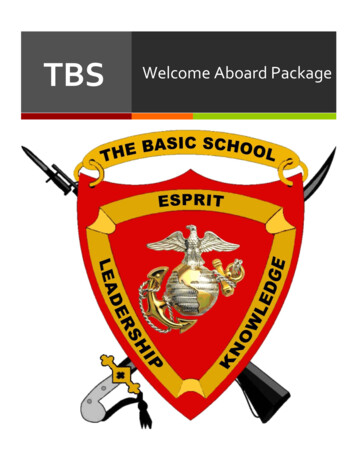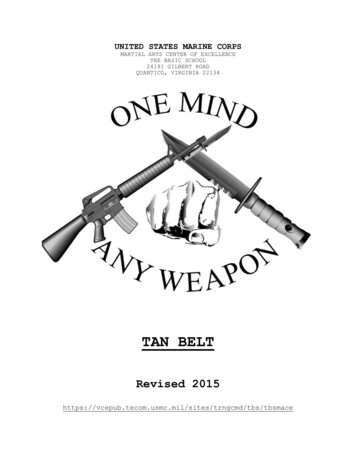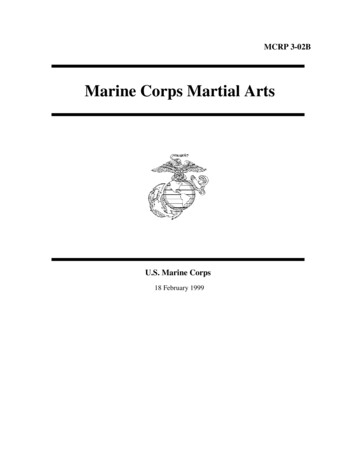
Transcription
MCRP 3-02BMarine Corps Martial ArtsU.S. Marine Corps18 February 1999
DEPARTMENT OF THE NAVYHeadquarters United States Marine CorpsWashington, D.C. 20380-177518 February 1999FOREWORD1. PURPOSEToday’s Marines operate within a continuum of force where conflict may change fromlow intensity to high intensity over a matter of hours. Marines are also engaged inmany military operations other than war, such as peacekeeping missions or noncombatant evacuation operations, where deadly force may not be authorized. During noncombative engagements, Marines must determine if a situation warrants applyingdeadly force. Sometimes Marines must decide in a matter of seconds because theirlives or the lives of others depend on their actions. To make the right decision,Marines must understand both the lethal and nonlethal close combat techniques needed to handle the situation responsibly without escalating the violence unnecessarily.Marine Corps Reference Publication (MCRP) 3-02B, Close Combat, provides the tactics, techniques, and procedures of Marine Corps close combat. It also provides thedoctrinal basis for the Marine Corps Close Combat Training Program (MCCCTP).2. SCOPEThis publication guides individual Marines, unit leaders, and close combat instructorsin the proper tactics, techniques, and procedures for close combat. MCRP 3-02B isnot intended to replace supervision by appropriate unit leaders and close combat instruction by qualified instructors. Its role is to ensure standardization and execution oftactics, techniques, and procedures throughout the Marine Corps.3. SUPERSESSIONMCRP 3-02B supersedes Fleet Marine Force Manual (FMFM) 0-7, Close Combat,dated 9 July 1993. There are significant differences between the two publications.MCRP 3-02B should be reviewed in its entirety.
4. WARNINGTechniques described in this publication can cause serious injury or death. Practicalapplication in the training of these techniques will be conducted in strict accordancewith approved Entry Level Close Combat, Close Combat Instructor (CCI), and CloseCombat Instructor Trainer (CCIT) lesson plans. Where serious danger exists, the reader is alerted by the following:WARNING5. CERTIFICATIONReviewed and approved this date.BY DIRECTION OF THE COMMANDANT OF THE MARINE CORPSJ. E. RHODESLieutenant General, U.S. Marine CorpsCommanding GeneralMarine Corps Combat Development CommandDISTRIBUTION: 144 000066 00
OVERVIEW OF CLOSE COMBAT1. Purpose of Close CombatClose combat is the physical confrontation between two or more opponents. It involves armedand unarmed and lethal and nonlethal fightingtechniques that range from enforced complianceto deadly force. The purpose of close combat is toexecute armed and unarmed techniques to produce both lethal and nonlethal results. Unarmedtechniques include hand-to-hand combat and defense against hand-held weapons. Armed techniques include techniques applied with a rifle,bayonet, knife, baton, or any weapon of opportunity.one person complies with the demands imposedby another person. This range of actions is knownas a continuum of force. Continuum of force is theconcept that there is a wide range of possible actions, ranging from voice commands to application of deadly force, that may be used to gain andmaintain control of a potentially dangerous situation (MCO 5500.6 , Arming of Security and LawEnforcement [LE] Personnel and the Use ofForce). Continuum of force consists of five levelsthat correspond to the behavior of the people involved and the actions Marines use to handle thesituation (see the table below). Close combattechniques are executed in levels three, four, andfive.Level One: Compliant (Cooperative)2. Continuum of ForceThe subject complies with verbal commands.Close combat techniques do not apply.Marines will find themselves in both combativeand noncombative situations. The threat level inthese situations can rise and fall several timesbased on the actions of both Marines and the people involved. The escalation of force stops whenLevel Two: Resistant (Passive)The subject resists verbal commands but compliesimmediately to any contact controls. Close combat techniques do not apply.Continuum of ForceLevelDescriptionActions1Compliant (Cooperative)Verbal commands2Resistant (Passive)Contact controls3Resistant (Active)Compliance techniques4Assaultive (Bodily Harm)Defensive tactics5Assaultive (Serious Bodily Harm/Death)Deadly forceNote: Shading indicates levels in which Marines use close combat techniques.
vi MCRP 3-02BLevel Three: Resistant (Active)The subject initially demonstrates physical resistance. Marines use compliance techniques to control the situation. Level three incorporates closecombat techniques to physically force a subject tocomply. Techniques include—lllCome-along holds.Soft-handed stunning blows.Pain compliance through joint manipulationand the use of pressure points.Level Four: Assaultive (BodilyHarm)The subject may physically attack Marines, but hedoes not use a weapon. Marines use defensive tactics to neutralize the threat. Defensive tactics include the following close combat techniques:lllllBlocks.Strikes.Kicks.Enhanced pain compliance procedures.Nightstick blocks and blows.Level Five: Assaultive (SeriousBodily Harm/Death)The subject usually has a weapon and will eitherkill or seriously injure someone if he is notstopped immediately and brought under control.Typically, to control the subject, Marines applydeadly force through the use of a firearm, but theymay also use armed and unarmed close combattechniques.achieve an effect that is greater than their separatesum.Achieving a DecisionAchieving a decision is important in closecombat. An indecisive fight wastes energy andpossibly Marines’ lives. Whether the intent is tocontrol an opponent through restraint or defendthemselves in war, Marines must have a clear purpose before engaging in close combat and act decisively once engaged.Gaining an AdvantageA basic principle of martial arts is to use the opponent’s strength and momentum against him togain more leverage than one’s own muscles alonecan generate, thereby gaining an advantage. Inclose combat, Marines must exploit every advantage over an opponent to ensure a successful outcome. This can include employing variousweapons and close combat techniques that willpresent a dilemma to an opponent. Achieving surprise can also greatly increase leverage. Marinestry to achieve surprise through deception, stealth,and ambiguity.SpeedMarines use speed to gain the initiative and advantage over the enemy. In close combat, thespeed and violence of the attack against an opponent provides Marines with a distinct advantage.Marines must know and understand the basics ofclose combat so they can act instinctively withspeed to execute close combat techniques.Adapting3. Marine Corps TacticalConceptsClose combat techniques support the followingkey Marine Corps tactical concepts. The conceptsare not standalone ideas but are to be combined toClose combat can be characterized by friction, uncertainty, disorder, and rapid change. Each situation is a unique combination of shifting factorsthat cannot be controlled with precision or certainty. For example, a crowd control mission maycall for Marines to employ various techniquesranging from nonlethal restraint to more forcefulapplications. Marines who adapt quickly willhave a significant advantage.
Close Combat viiExploiting SuccessTypically, an enemy will not normally surrendersimply because he was placed at a disadvantage.Marines cannot be satisfied with gaining an advantage in a close combat situation. They mustexploit any advantage aggressively and ruthlesslyuntil an opportunity arises to completely dominate the opponent. Marines must exploit successby using every advantage that can be gained.(reverse blank)
Close CombatTable of ContentsPageOverview of Close CombatChapter 1.1.2.3.4.5.6.7.8.Ranges of Close CombatWeapons of the BodyTarget Areas of the BodyPressure Points of the BodyBasic Warrior StanceAngles of Approach and MovementBalance and Off-BalancingFallsChapter 2.1.2.3.4.1.2.3.4.5.2-12-62-82-12Hand-Held WeaponsFundamentals of Knife FightingKnife Fighting TechniquesWeapons of OpportunityFundamentals of Combative StickCombative Stick TechniquesBlocking TechniquesUnarmed Against Hand-Held WeaponsCounters to Hand-Held Weapon AttacksChapter 4.1-11-21-31-41-61-71-81-9Lethal and Nonlethal Weapons TechniquesBayonet TechniquesNonlethal Rifle and Shotgun Retention TechniquesNonlethal Handgun Retention TechniquesFirearm Disarmament TechniquesChapter 3.1.2.3.4.5.6.7.8.Fundamentals of Close Combat3-13-33-63-63-73-93-113-13StrikesPrinciples of PunchesPunchesStrikes with the Upper BodyStrikes with the Lower BodyCounters to Strikes4-14-24-44-104-12
Close CombativPageChapter 5.Throws1. Turning Throw2. Hip Throw3. Leg SweepChapter 6.Chokes and Holds1. Types of Chokes2. Chokes3. Counters to Chokes and HoldsChapter 7.6-16-16-5Ground Fighting1. Offensive Ground Fighting2. Defensive Ground Fighting3. Ground Fighting ChokesChapter 8.5-15-25-37-17-37-5Nonlethal Techniques1. Unarmed Restraints and Manipulation2. Nonlethal Baton8-18-9AppendicesA. Pugil Stick TrainingB. Safety Precautions During TrainingA-1B-1
CHAPTER 1FUNDAMENTALS OF CLOSE COMBATThis chapter describes all techniques for a right-handed person.However, all techniques can be executed from either side.The Marine is depicted in camouflage utilities. The opponent isdepicted without camouflage.The fundamentals of close combat include ranges,weapons of the body, target areas of the body, andpressure points of the body. These fundamentalsform the basis for all close combat techniques.They provide Marines with a common frameworkregardless of the type of confrontation or the techniques used. If Marines apply these fundamentalsproperly in a close combat situation, they maysave their lives or the lives of fellow Marines.1. Ranges of Close CombatClose combat engagements occur within threeranges: long range, midrange, and close range.During any engagement, these ranges may blurtogether or may rapidly transition from one to another until either the opponent is defeated or theconflict is resolved.Long RangeDuring long range engagements, combatants engage each other with rifles, bayonets, sticks, orentrenching tools. See figure below.
1-2MCRP 3-02BMidrangeFists. To minimize injuryDuring midrange engagements, combatants engage each other with knives, punches, or kicks.to the fists, Marines usetheir fists as weapons totarget soft tissue areassuch as the throat. Thefists’ striking surfaces arethe first two knuckles ofthe hands or the meatyportions of the hands below the little fingers.Edge of Hand. Marinesuse the edge of the hand(knife edge) as a weapon.Marines use the edge ofthe hand to strike soft tissue areas.Close RangeDuring close range engagements, combatantsgrab each other. Close range engagements also involve elbow strikes, knee strikes, and grappling.Palms. Because of thepalm’s padding, Marinesuse the heels of the palmsto strike, parry, and/orblock.Fingers. Marines use thefingers to gouge, rip, andtear soft tissue areas (e.g.,eyes, throat, groin).2. Weapons of the BodyHands and ArmsThe hands, forearms, and elbows are the arm’s individual weapons. The hands consist of severalareas that can be used as weapons: fists, edges ofhands, palms, and fingers.Forearms. Marines use the forearms as a defen-sive tool to deflect or block attacks. Forearms canalso be used as striking weapons to damage orbreak an opponent’s joints and limbs. Marinessustain less self-injury when strikes are conducted
Close Combatwith the forearms than when strikes are conductedwith fists and fingers.1-3devastating secondary attack to an opponent’sface following an initial attack that caused him tobend at the waist.Elbows. Marines use the elbows as strikingweapons. Because of the short distance needed togenerate power, elbows are excellent weapons forstriking during the close range of close combat.3. Target Areas of the BodyDuring close combat, Marines strive to attack theaccessible target areas of an opponent’s body. Thereadily accessible areas will vary with each situation and throughout the engagement. The targetareas are divided into five major groups: head,neck, torso, groin, and extremities. The figure below illustrates target areas of the body.LegsThe legs are more powerful than any other weapon of the body, and they are less prone to injurywhen striking. The feet are protected by boots andare the preferred choice for striking.Feet. Marines use the balls of the feet, the insteps,and the toes to kick an opponent. Marines use thecutting edge of the heels and the heels to stomp onan opponent. Marines must be wearing bootswhen striking with the toes.HeadThe vulnerable regions of the head are the eyes,temple, nose, ears, and jaw. Massive damage tothe head kills an opponent.Knees. Like elbows, knees are excellent weaponsin the close range of close combat. Knee strikesare most effective while fighting close to an opponent where kicks are impractical. The opponent’sgroin area is an ideal target for the knee strike ifhe is standing upright. Knee strikes can deliver aTempleEyesEarsEyes. The eyes are excellent targets because theyare soft tissue areas that are not protected by boneor muscle. Attacks to this area may cause the opponent to protect the area with his hands, allowingMarines to execute a secondary attack to otherNoseCervical VertebraeCarotid SinusJawClavicleSolar PlexusExtremitiesRibsKidneysGroinExtremities
1-4MCRP 3-02Btarget areas while the opponent uses his hands toprotect his eyes.and spinal cord. Excessive damage to this areacauses pain, paralysis, or death.Temple. The temple is one of the most fragile ar-Torsoeas of the head. Powerful strikes to the opponent’stemple cause permanent damage and death.Clavicle. The opponent’s clavicle (or collar bone)can be easily fractured, causing immobilization ofthe arm.Nose. The nose is very sensitive and easily bro-ken. An attack to this area causes involuntary watering and closing of the opponent’s eyes,rendering him vulnerable to secondary attacks.However, through training, individuals can condition themselves to withstand attacks to the nose.Therefore, any attack to the nose must be powerfully delivered.Ears. Attacks to the ears may cause the eardrumto rupture. But this may not stop or even distractan opponent unless Marines powerfully deliverthe strike.Jaw. The jaw region, when struck forcefully, ren-ders the opponent unconscious. Strikes to the jawcause painful injuries to the teeth and surroundingtissues (e.g., lips, tongue), but the risk of self-injury is great unless Marines deliver strikes with ahard object such as a helmet, rifle butt, or bootheel.NeckThe front of the neck, or throat area, is a soft tissue area that is not covered by natural protection.Damage to this region causes the opponent’s trachea to swell, closing his airway, which can leadto death.Carotid Sinus. The carotid sinus is located onboth sides of the neck just below the jaw. Strikesto the carotid sinus restrict blood flow to thebrain, causing loss of consciousness or death.Cervical Vertebrae. The cervical vertebrae onthe back of the neck, from the base of the skull tothe top of the shoulders, contains the spinal cord,which is the nervous system’s link to the brain.The weight of the head and the lack of large muscle mass allow damage to the cervical vertebraeSolar Plexus. Attacks to the opponent’s solarplexus or center of the chest can knock the breathout of him and immobilize him.Ribs. Damage to the opponent’s ribs immobilizeshim. It may also cause internal trauma.Kidneys. Powerful attacks to the opponent’s kid-neys cause immobilization, permanent damage, ordeath.GroinThe groin area is another soft tissue area not covered by natural protection. Any damage to this area causes the opponent to involuntarily protect hisinjured area, usually with his hands or legs. Inmale opponents, the scrotum is the main targetsince even a near miss causes severe pain, contraction of the lower abdominal muscles, deterioration of his stance, and possible internal trauma.ExtremitiesRarely will an attack to the opponent’s extremities (arms and legs) cause death, but they are important target areas in close combat. Damage toan opponent’s joints causes immobilization.4. Pressure Points of the BodyThere are nerves in the human body that, whenpressure is applied or when they are struck, allowMarines to control a subject through pain compliance. Marines use pressure points to control anopponent when deadly force is not authorized.They also use pressure points to soften or distractan opponent so a lethal or nonlethal technique canbe employed. The figure on page 1-5 illustrates
Close Combatthe body’s pressure points. Marines execute attacks to pressure points by—llRapidly kicking or striking pressure points.Slowly applying steady pressure to pressurepoints.1-5Jugular NotchThe jugular notch is at the base of the neck in thenotch formed at the center of the clavicle. Marinesapply pressure in a quick, stabbing motion withthe index finger. Strikes to the jugular notch causeserious damage.Infraorbital NerveBrachial Plexus (Tie In)The infraorbital nerve is just below the nose.Marines apply pressure to this nerve with an index finger to control the opponent.The brachial plexus (tie in) is on the front of theshoulder at the joint. Strikes and pressure appliedwith the hand are effective on this nerve.Mastoid ProcessRadial NervesThe mastoid process is behind the base of the earand beneath the edge of the jaw. Marines applyinward and upward pressure to this pressure pointwith the fingers to distract and control the opponent.Radial nerves are on the inside of the forearmsalong the radius bones. Strikes and pressure applied with the hand to the radial nerve serve as asoftening technique.
1-6Ulnar NerveUlnar nerves are on the outside of the forearmsalong the ulnar bones. Strikes and pressure applied with the hand to the ulnar nerve serve as asoftening technique.MCRP 3-02Bthe basic warrior stance, Marines put their feetapart, hands up, elbows in, and chin down.Feet ApartPlace feet shoulder-widthapart.Pressure Point on the HandKeep the head forward andeyes on the opponent, take ahalf step forward with the leftfoot, and pivot on the heels sothe hips and shoulders are atapproximately a 45-degree angle to the right.The hands contain a pressure point on the webbing between the thumbs and index fingers wherethe two bones of the fingers meet.To force an opponent to soften or release his grip,Marines apply pressure with their index fingers tothis pressure point or strike this pressure pointwith their fists.Distribute body weight evenlyon both legs. Bend the kneesslightly.Femoral NervesFemoral nerves are on the inside of the thighsalong the femur bones. Strikes to the femoralnerve serve as a softening technique.Peroneal NervesPeroneal nerves are on the outside of the thighsalong the femur bones. Strikes to the peronealnerve serve as a softening technique.Pressure Points on the FeetThere are pressure points on the feet that, whenpressure is applied or when they are struck, serveto soften or distract the opponent. Marines applypressure with the toe, edge, or heel of their bootsto the following points:lllHands UpCurl the fingers naturally into the palm of thehand. Position the thumb across the index andmiddle fingers. Do not clench the fists. Clenchingthe fists increases muscular tension in the forearms and decreases speed and reaction time.Bring the hands up to the face at chin level, withthe palms facing each other. Hold the fists up highenough to protect the head, but not so high thatthey block the field of vision. Ensure continuouseye contact with the opponent.The notch below the ball of the ankle.The top center of the foot, above the toes.The top of the foot where the leg and footmeet.5. Basic Warrior StanceElbows InTuck the elbows in close to protect the body.Achieving a solid stance is critical to stability andmovement throughout any close combat confrontation. The basic warrior stance provides the foundation for stability and movement that is neededto execute close combat techniques. To executeChin DownTuck the chin down to take advantage of the natural protection provided by the shoulders.
Close Combat6. Angles of Approach andMovementForward to the Left. To move forward to the leftfrom the basic warrior stance, Marines—lMarines use movement to control a confrontationand to retain a tactical advantage. Movement increases power and maximizes momentum. Bymoving around the opponent, Marines gain accessto different target areas of the opponent’s body.Movement allows Marines to use different weapons of the body and different close combat techniques to attack specific target areas.1-7lMove the left foot forward at a 45-degreeangle from the body (approximately 12 to15 inches), keeping the toe pointed towardthe opponent.Bring the right foot behind the left foot assoon as the left foot is in place. This returnsMarines to the basic warrior stance.Forward to the Right. To move forward to theright from the basic warrior stance, Marines—Angles of ApproachMarines move anywhere within a 360-degree circle around the opponent to gain a tactical advantage. This circle provides access to different targetareas of the opponent’s body.When facing an opponent, Marines move in a 45degree angle to either side of the opponent. Moving at a 45-degree angle avoids an opponent’sstrike and puts Marines in the best position to attack the opponent. Marines should avoid beingdirectly in front of an opponent during a confrontation. If a Marine is directly in front of an opponent, the opponent can rely on his forwardmomentum and linear power to seize the tacticaladvantage.MovementMarines must know how to move in all directionswhile maintaining the basic warrior stance. During any movement, the legs or feet should not becrossed. Once a movement is completed, the basicwarrior stance should be resumed. Maintainingthe basic warrior stance protects Marines and putsthem in the proper position to launch an attackagainst an opponent.Note: Before body movement begins, Marinesturn their heads quickly to the new direction. Thefaster the head turns, the faster the body moves,and the quicker Marines attain visual contactwith the opponent.llMove the right foot forward at a 45-degreeangle from the body (approximately 12 to15 inches).Bring the left foot, toe pointing toward theopponent, in front of the right foot as soonas the right foot is in place. This returnsMarines to the basic warrior stance.Backward to the Left. To move backward to theleft from the basic warrior stance, Marines execute the forward movement in reverse. Marines—llMove the left foot backward at a 45-degreeangle from the body (approximately 12 to15 inches), keeping the toe pointed towardthe opponent.Bring the right foot behind the left foot assoon as the left foot is in place. This returnsMarines to the basic warrior stance.Backward to the Right. To move backward tothe right from the basic warrior stance, Marinesexecute the forward movement in reverse.Marines—llMove the right foot backward at a 45-degreeangle from the body (approximately 12 to15 inches).Bring the left foot, toe pointing toward theopponent, in front of the right foot as soonas the right foot is in place. This returnsMarines to the basic warrior stance.
1-8MCRP 3-02B7. Balance and Off-BalancingAngles of Off-balancingBalanceThere are eight angles or directions in which anopponent can be off-balanced: forward, rear,right, left, forward right, forward left, rear right,and rear left.In any close combat situation, Marines must striveto maintain balance. The last place to be in a closecombat situation is on the ground. Marines mustmaintain a strong base and a low center of balance, their feet must be a shoulder-width apart,and they must stay on their toes to enable quickmovement.Off-balancingMarines use off-balancing techniques to controlan opponent. These techniques are used to throwan opponent to the ground while Marines remainstanding, or they are used to put Marines in a position for an offensive attack.Off-balancing techniques use the opponent’s momentum to move or throw him. For example, ifthe opponent is charging a Marine, the Marinepulls the opponent to drive him to the ground.Likewise, if the opponent is pulling a Marine, theMarine pushes the opponent to drive him to theground.Off-balancing techniques also rely on the powergenerated by the opponent. For example, duringcombat a Marine may be tired or outnumbered.Depending on the generated energy and momentum of the opponent, the Marine employs off-balancing techniques with very little effort and stillprovides effective results.Because off-balancing techniques rely on the momentum and power generated by the opponent,these techniques are particularly effective forMarines who may be outsized by their opponentor lack their opponent’s strength.Note: The angles correspond to the Marine’sperspective, not the opponent’s. Forward, rear,right, and left are straight angles. Forward right,forward left, rear right, and rear left are considered quadrants that are at a 45-degree angle ineither direction to the front or rear.Off-balancing TechniquesMarines off-balance an opponent by pushing,pulling, or bumping the opponent with theirhands, arms, or bodies.To pull, Marines grab an opponent with theirhands and drive him forcefully to one of the rearquadrants or to the right or left.
Close CombatTo push, Marines grab the opponent with theirhands and drive him forcefully into one of thefront quadrants or to the right or left.Marines execute bumping in the same manner aspushing, but use their shoulders, hips, and legs instead of their hands to off-balance the opponent.1-9Fall forward, breaking the fall with the forearmsand palms. The forearms and hands, down to thefingertips, should strike the ground simultaneously.Offer resistance with the forearms and hands tokeep the head raised off the ground.8. FallsMarines may lose their balance or be thrown tothe ground during encounters with an opponent.Marines use falling techniques to absorb the impact of a fall and to quickly return to their feet following an opponent’s attack.Whether falling or being thrown by an opponent,Marines strive to reduce the force of the impact,to prevent serious personal injury, and to increasethe chances of survival. Falling techniques use thebody’s large muscles (back, thighs, buttocks) toprotect vital organs and bones from injury and immobilization.Side FallMarines execute a side fall to break a fall on theside. To execute the side fall, Marines—Bring the right arm across the body so the hand isnext to the left shoulder with the palm facing inboard.Front FallMarines execute a front fall to break a fall on thefront. To execute the front fall, Marines—Bend the elbows and place the palms facing out ina position to spread and absorb the impact of thefall.Fall to the side, breaking the fall with the rightarm by slapping the ground and making contactfrom the shoulder or forearm down to the hand.At the same time, tuck the chin and keep the head
1-10MCRP 3-02Braised off the ground. The chin should be tuckedto the chest at all times to prevent whiplash.Fall backward and slap the ground with the forearms and hands to absorb the impact of the falland keep the head off the ground.Stretch the right leg out to make contact with theground and to distribute and absorb the impact.Bend the left leg, allowing the foot to make contact with the ground.Forward Shoulder RollMarines use the forward shoulder roll to break afall from an opponent’s attack and to use the momentum of the fall to get back on their feet quickly. Ideally, Marines execute the forward shoulderroll to a standing position so they can continuefighting. To execute the forward shoulder roll,Marines—Contact the ground with the back of the right forearm and upper arm. Tuck the chin into the chest.Back FallMarines execute a back fall to break the fall whenbeing thrown or falling backward. To execute theback fall, Marines—Cross the hands in front of the chest and tuck thechin.Roll onto the right shoulder, rolling diagonallyacross the back to land on the left hip.Slap the ground with the left arm, absorbing theimpact from the shoulder to the hand, palm down.
Close CombatKeep the left leg straight to absorb as much of theimpact as possible. The right leg is bent and thefoot hits flat on the ground.1-11Bend the left leg upon impact to push off with theleft knee and leg to a squatting and then a standing position. Forward momentum should carry theMarine to a standing position.(reverse blank)
CHAPTER 2LETHAL AND NONLETHAL WEAPONS TECHNIQUESThis chapter describes all techniques for a right-handed person.However, all techniques can be executed from either side.In drawings, the Marine is depicted in woodland camouflage utilities; the opponent is depicted without camouflage. In photographs,the Marine is depicted in woodland camouflage utilities; the opponent is depicted in desert camouflage utilities.1. Bayonet TechniquesWARNINGDuring training, Marines must have bayonetssheathed. Marines use bayonet dummies topractice bayonet techniques. When practicing offensive and defensive bayonet techniques student-on-student, Marines use pugilsticks.All Marines armed with a rifle carry a bayonet.The bayonet is an effective weapon if Marines areproperly trained in offensive and defensive bayonet techniques. An offensive attack, such as athrust, is a devastating attack that can quickly enda fight. Defensive techniques, such as the blockand parry, can deter the opponent’s attack and allow Marines to regain the
MCRP 3-02B Mar
